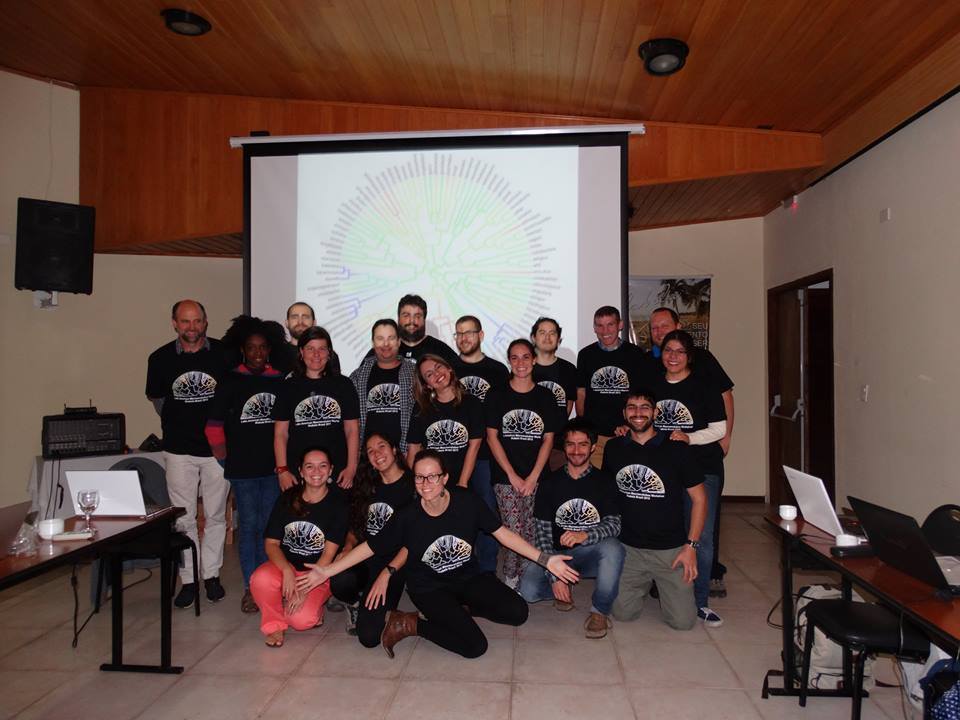Since our second Latin American Macroevolution workshop - this year held in Ilhabela, Brazil - is now done, I thought I'd post a quick update on our final t-shirt design. I posted a prototypical version earlier on this blog; however subsequent to making that design we decided to switch from a continuous character map, so a stochastically mapped discrete character using a Brazilian flag color palette. Here is the result:
library(phytools)
## read in tree
tree<-read.tree(text="(((t2:0.41,((t15:0.116,(t68:0.03,t69:0.03):0.086):0.18,(((t43:0.058,((t97:0.001,t98:0.001):0.03,t67:0.032):0.027):0.072,((t95:0.002,t96:0.002):0.028,t70:0.03):0.1):0.072,t5:0.202):0.094):0.114):0.004,((((((t76:0.022,t77:0.022):0.05,(t61:0.034,t62:0.034):0.038):0.03,((t91:0.005,t92:0.005):0.021,t75:0.026):0.076):0.083,t9:0.185):0.2,(((t10:0.16,((t30:0.078,(t80:0.014,t81:0.014):0.064):0.005,((((t99:0,t100:0):0.03,(t73:0.027,t74:0.027):0.004):0.004,t60:0.034):0.011,t51:0.045):0.038):0.077):0.054,(t7:0.188,(((t54:0.039,(t84:0.01,t85:0.01):0.028):0.09,t14:0.129):0.027,(t31:0.076,(t57:0.034,t58:0.034):0.042):0.08):0.032):0.026):0.083,(((t93:0.004,t94:0.004):0.002,t90:0.006):0.204,((t71:0.029,t72:0.029):0.101,t13:0.13):0.08):0.086):0.088):0.024,((t3:0.26,(t4:0.207,((t32:0.074,(t49:0.049,t50:0.049):0.026):0.099,(((((t78:0.018,t79:0.018):0.025,t52:0.042):0.054,t21:0.096):0.034,t12:0.13):0.01,(t33:0.074,((t65:0.032,t66:0.032):0.009,t53:0.041):0.032):0.067):0.032):0.034):0.053):0.016,(t11:0.154,(t26:0.086,((t55:0.036,t56:0.036):0.018,t46:0.054):0.032):0.068):0.122):0.132):0.004):0.086,((((t8:0.186,((t16:0.114,(t24:0.088,t25:0.088):0.027):0.008,(t40:0.068,t41:0.068):0.054):0.063):0.08,(((((t47:0.051,t48:0.051):0.044,t22:0.095):0.009,t18:0.104):0.053,((t19:0.102,((t83:0.012,(t86:0.01,t87:0.01):0.002):0.054,t42:0.068):0.034):0.018,((t23:0.09,(t28:0.085,t29:0.085):0.005):0.011,(t38:0.068,t39:0.068):0.034):0.018):0.038):0.03,((t44:0.057,t45:0.057):0.048,t17:0.104):0.082):0.08):0.082,(((t59:0.034,(t82:0.014,(t88:0.009,t89:0.009):0.004):0.021):0.13,(((t34:0.073,t35:0.073):0.013,t27:0.086):0.015,(t63:0.033,t64:0.033):0.068):0.064):0.059,(t6:0.19,((t36:0.072,t37:0.072):0.028,t20:0.1):0.09):0.033):0.125):0.098,t1:0.446):0.054);")
## create transition matrix
Q<-matrix(c(-3,1,1,1,
1,-3,1,1,
1,1,-3,1,
1,1,1,-3),4,4)
rownames(Q)<-colnames(Q)<-letters[1:4]
## simulate stochastic character history
tree<-sim.history(tree,Q)
## Done simulation(s).
cols<-setNames(c("#309030","#182B78","#F0F0F0","#F0C000","#134913"),
letters[1:4])
Now we're ready to make our plot:
layout(mat=matrix(c(1,2),2,1),heights=c(0.8,0.2))
par(bg="black")
par(fg="white")
plotSimmap(paintSubTree(tree,Ntip(tree)+1,"1"),type="fan",
ftype="off",colors=setNames("white","1"),lwd=6,part=0.5)
## setEnv=TRUE for this type is experimental. please be patient with bugs
plotSimmap(tree,colors=cols,type="fan",ftype="off",lwd=4,
add=TRUE,part=0.5)
## setEnv=TRUE for this type is experimental. please be patient with bugs
plot.new()
text(0.5,0.5,"Latin American Macroevolution Workshop\nIlhabela Brazil 2015",
col="white",cex=2.1,font=2)
Once again, if we want to produce a high quality version without the aliasing that we see in the plot above, we can do that easily by exporting as a pdf:
pdf(file="brazil-colors.pdf",width=8,height=4.75)
layout(mat=matrix(c(1,2),2,1),heights=c(0.8,0.2))
par(bg="black")
par(fg="white")
plotSimmap(paintSubTree(tree,Ntip(tree)+1,"1"),type="fan",
ftype="off",colors=setNames("white","1"),lwd=6,part=0.5)
## setEnv=TRUE for this type is experimental. please be patient with bugs
plotSimmap(tree,colors=cols,type="fan",ftype="off",lwd=4,
add=TRUE,part=0.5)
## setEnv=TRUE for this type is experimental. please be patient with bugs
plot.new()
text(0.5,0.5,"Latin American Macroevolution Workshop\nIlhabela Brazil 2015",
col="white",cex=2.1,font=2)
dev.off()
## png
## 2
This PDF can be found here.
Note that since the plot above used a stochastic simulation, the realized t-shirt design was actually slightly different (see below).
Finally, the course was a huge success (in my opinion). Certainly, the students we had this year (like last year) were fantastic, and they even seemed to like the t-shirts:

(Click for a larger version.)
Thanks to the TAs, my co-instructors Luke Harmon & Mike Alfaro, and, of course, the excellent students. We're already looking forward to next year!
The T-shirts are very Brazilian :) they looked beautiful! The course was fantastic. It was a great opportunity to know new analytical tools applied in Macroecology & Macroevolution. Thanks a lot for the opportunity to take this course ;)
ReplyDelete